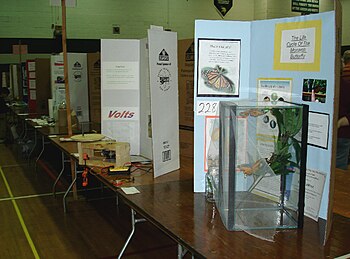Science fair: Difference between revisions
Yamaguchi先生 (talk | contribs) m Reverted edits by 156.110.39.26 (talk) to last version by ClueBot NG |
m Added more detailed information |
||
| Line 10: | Line 10: | ||
In the [[United States]], science fairs first became popular in the early 1950s, with the [[ISEF]], then known as the National Science Fair. Interest in the sciences was at a new high after the world witnessed the use of the first two [[atomic weapon]]s and the dawn of [[television]]. As the decade progressed, science stories in the news, such as [[Jonas Salk]]’s vaccine for [[polio]] and the launch of [[Sputnik]], brought science fiction to reality and attracted increasing numbers of students to fairs. |
In the [[United States]], science fairs first became popular in the early 1950s, with the [[ISEF]], then known as the National Science Fair. Interest in the sciences was at a new high after the world witnessed the use of the first two [[atomic weapon]]s and the dawn of [[television]]. As the decade progressed, science stories in the news, such as [[Jonas Salk]]’s vaccine for [[polio]] and the launch of [[Sputnik]], brought science fiction to reality and attracted increasing numbers of students to fairs. |
||
Successful science fair veterans include medical researcher Jack Andraka and inventor [[Alex Deans]]. |
|||
==History== |
==History== |
||
Revision as of 22:14, 28 March 2016
This article possibly contains original research. (August 2010) |
This article needs additional citations for verification. (July 2010) |

A science fair experiment is generally a competition where contestants present their science project results in the form of a report, display board, and models that they have created. Science fairs allow students in elementary, middle and high schools to compete in science and/or technology activities.
Although writing assignments that take a long time to complete and require multiple drafts are fairly common in US schools, large projects in the sciences (other than science fairs) are rare. Science fairs also provide a mechanism for students with intense interest in the sciences to be paired with mentors from nearby colleges and universities, so that they can get access to instruction and equipment that the local schools could not provide.
In the United States, science fairs first became popular in the early 1950s, with the ISEF, then known as the National Science Fair. Interest in the sciences was at a new high after the world witnessed the use of the first two atomic weapons and the dawn of television. As the decade progressed, science stories in the news, such as Jonas Salk’s vaccine for polio and the launch of Sputnik, brought science fiction to reality and attracted increasing numbers of students to fairs.
Successful science fair veterans include medical researcher Jack Andraka and inventor Alex Deans.
History
Science fairs were started by William Emerson Ritter and Edward W. Scripps in 1942 as "The Science Talent Search" for high school students. The first ever American National Science Fair was won by Alan J. Fletcher when he was 18, who demonstrated the laws of motion. 1950, Pennsylvania
Content
Science fairs projects are normally intended to demonstrate scientific concepts on a small scale and often relate to green energy or student health for example frequent science fair projects are how much water it takes to leave the water on while brushing your teeth, or what happens when you leave a tooth in a cup of soda. Science fair projects normally have to have a purpose, hypothesis, independent variable, dependent variable, experiment results, and a conclusion, and are normally intended to teach students about the scientific method.
